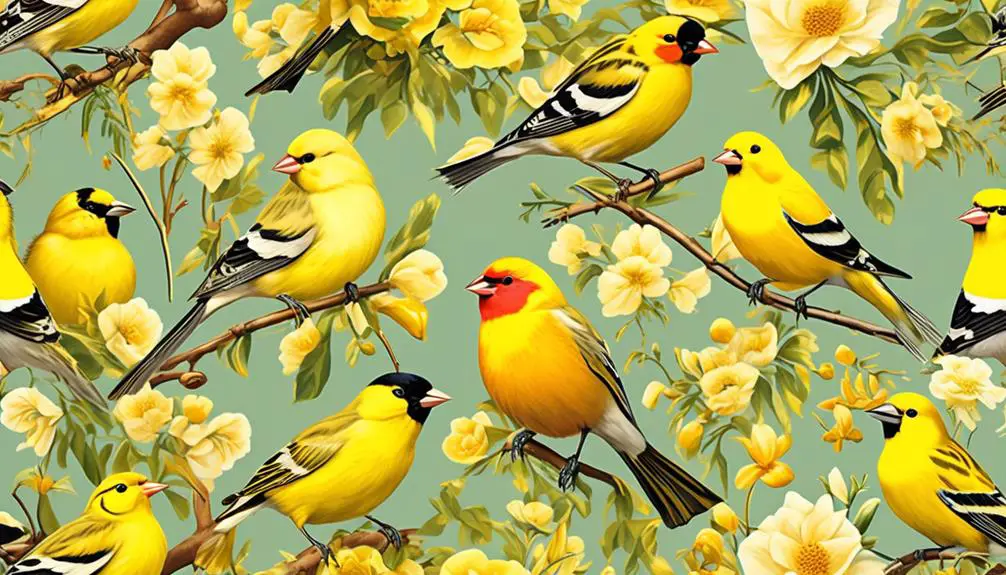Have you ever wondered how many types of yellow birds actually exist? It is often said that yellow birds are not only visually striking but also hold a special significance in various cultures.
As you explore the world of yellow birds, you will be amazed by the diversity and allure of these avian wonders. From the vibrant American Goldfinch to the charming Wilson’s Warbler, each species has its own unique characteristics and story to tell.
But there’s more to discover beyond their captivating appearances. So, prepare to be captivated as we embark on a journey to unravel the secrets of these enchanting creatures and uncover the joy they bring to our lives.
American Goldfinch
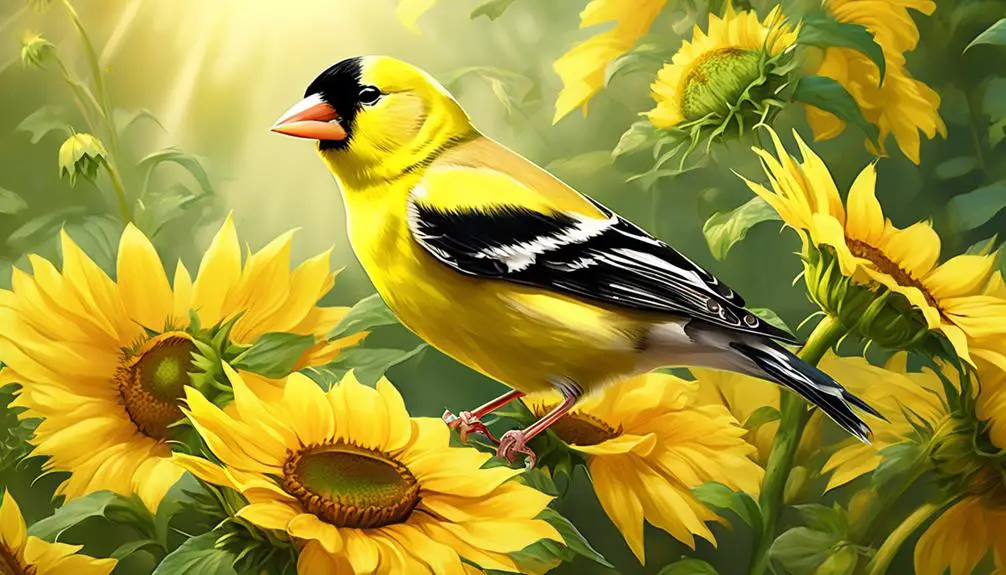
The American Goldfinch, a small and vibrant yellow bird, is a common sight in fields, meadows, and gardens across North America. Scientifically known as Spinus tristis, this species of finch belongs to the Fringillidae family. It’s a migratory bird that moves across North America, with a range extending from southern Canada to Mexico. The American Goldfinch displays sexual dimorphism, with the males sporting bright yellow plumage during the breeding season, while the females have a more subdued olive-brown color. They’ve a slender build, weighing between 0.4 to 0.7 ounces.
One interesting characteristic of the American Goldfinch is its granivorous nature. It primarily feeds on various seeds, including those from plants such as sunflowers, thistles, and ragweed. Their social behavior is also notable, as they often gather in flocks, especially during the non-breeding season. These flocks can consist of both males and females, with a hierarchical structure observed within the groups.
In terms of conservation status, the American Goldfinch is listed as least concern. This is due to its wide distribution and stable population numbers. Despite being a common sight, their bright yellow plumage and cheerful song make them a delightful addition to any garden or natural habitat.
Wilson’s Warbler
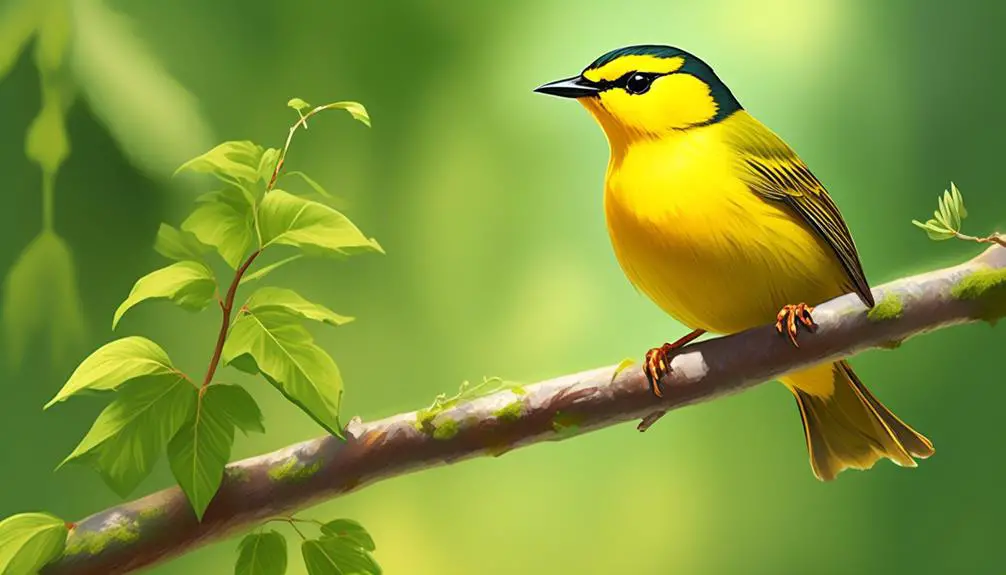
Now let’s delve into the fascinating world of Wilson’s Warbler.
This small songbird, scientifically known as Cardellina pusilla, measures between 3.9 and 4.7 inches in length and weighs only 0.2 to 0.3 ounces.
Found in woodlands and forests throughout the Americas, this warbler sports a vibrant green back with yellow plumage underneath, making it a striking sight in its natural habitat. Males also boast a distinctive black crown patch, adding to their unique appearance.
As an insectivore, Wilson’s Warbler feeds on a variety of prey, including beetles, caterpillars, and bees.
Color and Appearance
How does the Wilson’s Warbler differ in color and appearance from other yellow birds? The Wilson’s Warbler, scientifically known as Cardellina pusilla, stands out with its unique coloration and distinctive features. Unlike other yellow birds, the Wilson’s Warbler has a green back with yellow underneath, making it easily recognizable. The males of this species also have a black crown patch, adding to their striking appearance. This small warbler measures between 3.9 to 4.7 inches in length and weighs approximately 0.2 to 0.3 ounces. Its preferred habitat includes woodlands and forests, and it can be found in the Americas, including Canada, the United States, and Mexico. As an insectivore, the Wilson’s Warbler feeds on beetles, caterpillars, and bees. Its unique coloration and foraging behavior make it a fascinating addition to the world of yellow birds.
| Wilson’s Warbler | |
|---|---|
| Scientific Name | Cardellina pusilla |
| Length | 3.9 to 4.7 inches |
| Weight | 0.2 to 0.3 ounces |
| Habitat | Woodlands, forests |
| Where Found | Americas |
| Unique Features | Green back with yellow underneath, males have a black crown patch |
| Diet | Insectivore – feeds on beetles, caterpillars, and bees |
Habitat and Range
After learning about the unique coloration and distinctive features of the Wilson’s Warbler, let’s now explore its habitat and range.
The Wilson’s Warbler, scientifically known as Cardellina pusilla, is found in woodlands and forests across the Americas, including Canada, the United States, and Mexico.
This small bird measures between 3.9 to 4.7 inches in length and weighs about 0.2 to 0.3 ounces. It has a green back with yellow underneath, and males have a black crown patch.
The Wilson’s Warbler is an insectivore, feeding on beetles, caterpillars, and bees. It builds its nests in shrubs or low vegetation in its woodland habitat.
As a migratory species, the Wilson’s Warbler moves across its range during different seasons, making it a fascinating bird to observe in various parts of North America.
Yellow-Rumped Warbler
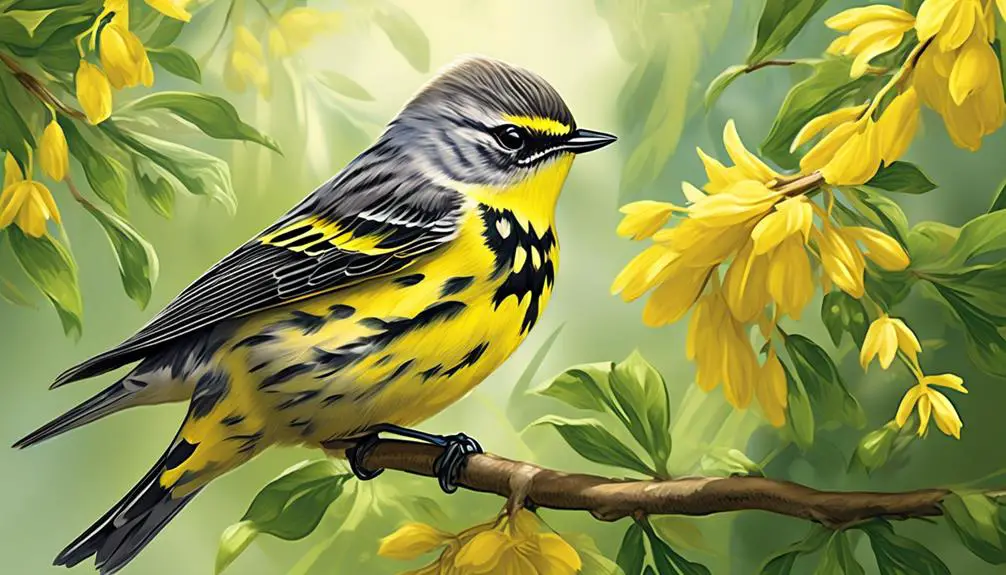
The Yellow-Rumped Warbler, scientifically known as Setophaga coronata, is a widespread and migratory bird species found primarily in North America. This species is known for its distinctive yellow rump, which gives it its name. The Yellow-Rumped Warbler is one of the most common warblers in North America and is easily recognized by its plumage. It has a length of about 5.5 inches and weighs between 0.3 to 0.4 ounces.
The Yellow-Rumped Warbler is primarily found in evergreen forests and forest edges, but it can also be seen in other habitats such as parks and gardens during migration. It’s a highly adaptable species that can survive in a variety of environments.
In terms of diet, the Yellow-Rumped Warbler is primarily insectivorous, feeding on insects such as beetles, caterpillars, and spiders. However, it’s also known to eat berries and fruits, especially during the winter months when insect availability is scarce. This species has a unique adaptation that allows it to digest waxes found in berries, making it one of the few warblers that can survive on a mainly fruit-based diet.
During migration, the Yellow-Rumped Warbler can be found across North America, from Alaska and Canada to Central America and the Caribbean. It’s a highly migratory bird, traveling long distances to its breeding and wintering grounds. In the spring and summer, it breeds in the northern parts of its range, while in the fall and winter, it migrates to the southern parts.
American Yellow Warbler
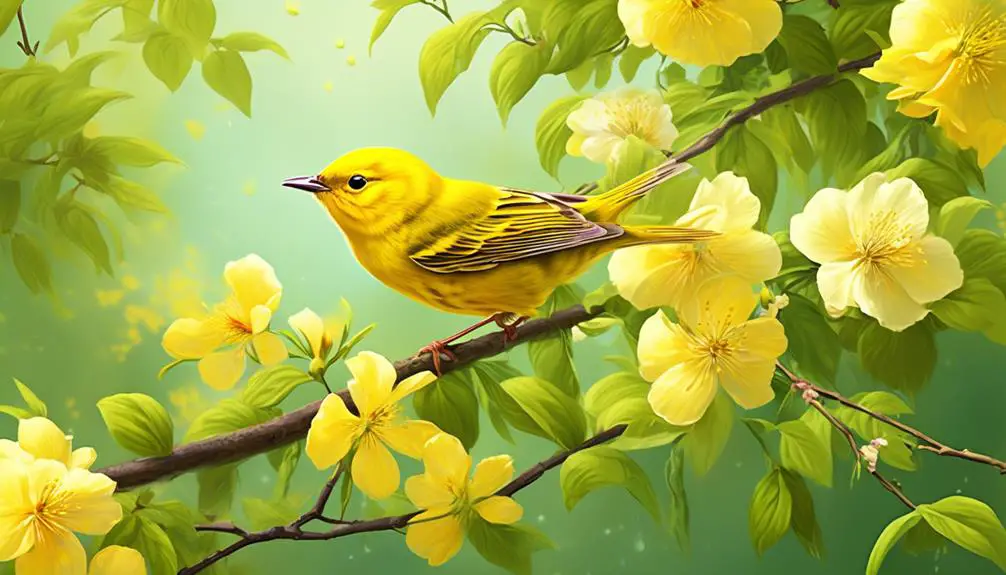
Moving on to the American Yellow Warbler, another species of yellow bird commonly found in North America is the Setophaga petechia.
The American Yellow Warbler, also known as the Yellow Warbler, is the most widespread warbler in the Americas. With a length ranging from 3.9 to 7.1 inches and a weight between 0.25 to 0.88 ounces, this species showcases a yellowish-green plumage with a dull yellow belly.
Its habitat includes bushes, swamps, edges, streams, and gardens, making it a versatile bird in terms of its preferred environment. The American Yellow Warbler primarily feeds on caterpillars, but it also consumes other insects. Its diet reflects its role as an insectivore, aiding in the ecological balance by controlling insect populations.
This species can be found throughout the Americas, making it a familiar sight to birdwatchers and nature enthusiasts. With its bright and vibrant coloration, the American Yellow Warbler adds a touch of beauty to the natural landscapes it inhabits.
Common Yellowthroat
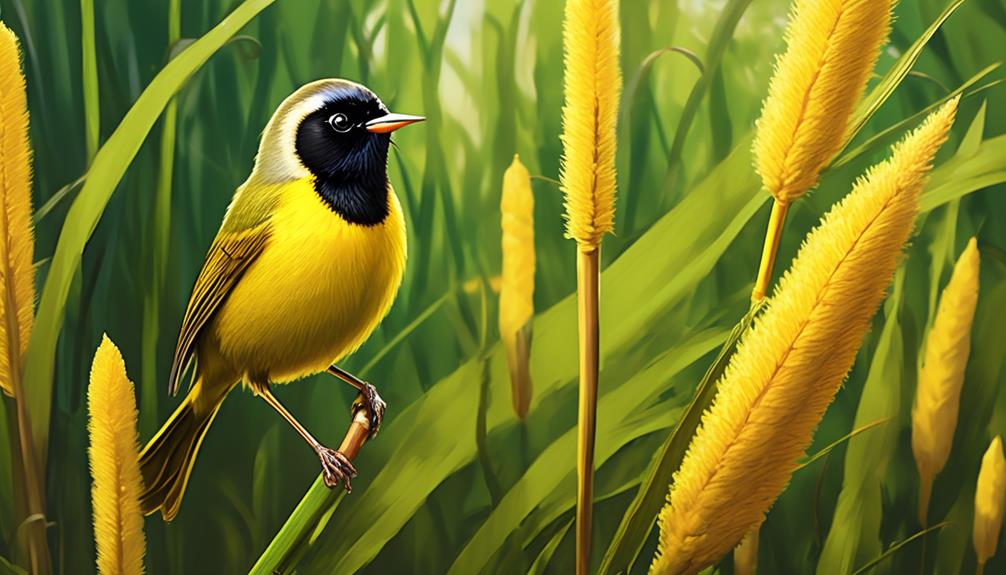
The Common Yellowthroat, scientifically known as Geothylpis trichas, is a small songbird that measures 4.3 to 5.1 inches in length and weighs about 0.3 ounces.
This species can be found mainly in North America, inhabiting marshes, wet thickets, edges, and swamps.
It’s characterized by its olive-colored back, wings, and tails, with males having a distinctive black face mask to attract females.
Physical Characteristics
Common Yellowthroats are small, migratory birds with distinctive physical characteristics. These birds are approximately 4.3 to 5.1 inches in length and weigh around 0.3 ounces. They can be found in habitats such as marshes, wet thickets, edges, and swamps in North America. Common Yellowthroats have olive-colored backs, wings, and tails, and their identifying feature is a yellow throat. Male Common Yellowthroats have a black face mask that helps attract females. To provide a clearer understanding of the physical characteristics of Common Yellowthroats, here is a table:
| Physical Characteristics | Measurements |
|---|---|
| Length | 4.3 to 5.1 inches |
| Weight | 0.3 ounces |
| Habitat | Marshes, wet thickets, edges, swamps |
| Where Found | North America |
| Identifying Feature | Yellow throat |
These physical characteristics make Common Yellowthroats unique among yellow birds.
Habitat and Behavior
With their distinct physical characteristics described, it’s essential to explore the habitat and behavior of the Common Yellowthroat, a small migratory bird found in North America.
The Common Yellowthroat is typically found in marshes, wet thickets, edges, and swamps, where it thrives in dense vegetation. This bird is mainly distributed across North America, utilizing these habitats for breeding and nesting during the spring and summer months.
The Common Yellowthroat is known for its distinctive yellow throat, olive-colored back, wings, and tails, and the males have a black face mask for attracting females.
Their behavior is characterized by their secretive nature, as they tend to stay hidden in dense vegetation and communicate through a series of distinctive songs and calls. These birds are insectivores, feeding primarily on insects such as caterpillars and spiders.
During migration, the Common Yellowthroat travels long distances to reach its wintering grounds in Central and South America.
Western Kingbird
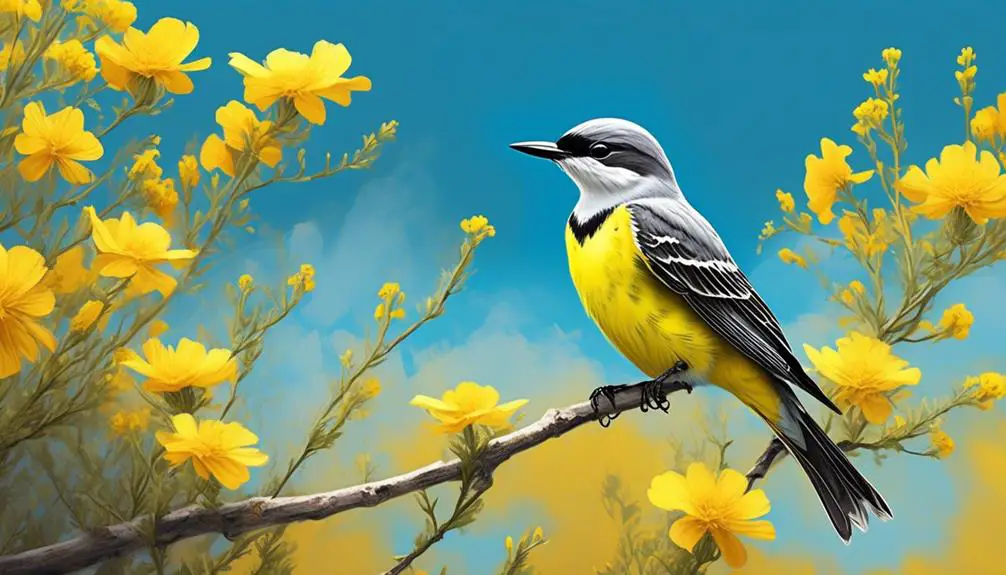
In North America, the Western Kingbird is a notable yellow bird species found in open areas. Scientifically known as Tyrannus verticalis, this species measures between 8 to 9.3 inches in length and weighs approximately 1.4 ounces. Its preferred habitat consists of open areas, where it can be easily observed perched on fences, utility wires, or tree branches. The Western Kingbird has a distinct appearance, with a yellow belly, gray head, and olive-colored back and wings. Additionally, it displays a white tip on its tail feathers.
To provide a deeper understanding of the Western Kingbird, let’s take a look at its behavioral characteristics in the table below:
| Behavior | Description |
|---|---|
| Diet | Feeds on insects, berries, and small fruits |
| Nesting | Builds cup-shaped nests in trees or shrubs |
| Migration | Migratory bird that travels to Central and South America |
| Vocalizations | Produces loud, sharp calls to communicate and defend territory |
| Breeding | Monogamous species that breeds between May and July |
The Western Kingbird is known for its aggressive behavior, often seen defending its territory against intruders, including larger birds. It is also an aerial insectivore, catching insects in mid-air using its quick and agile flight. During the breeding season, males perform aerial displays to attract females and establish their nesting territory.
Yellow-Headed Blackbird
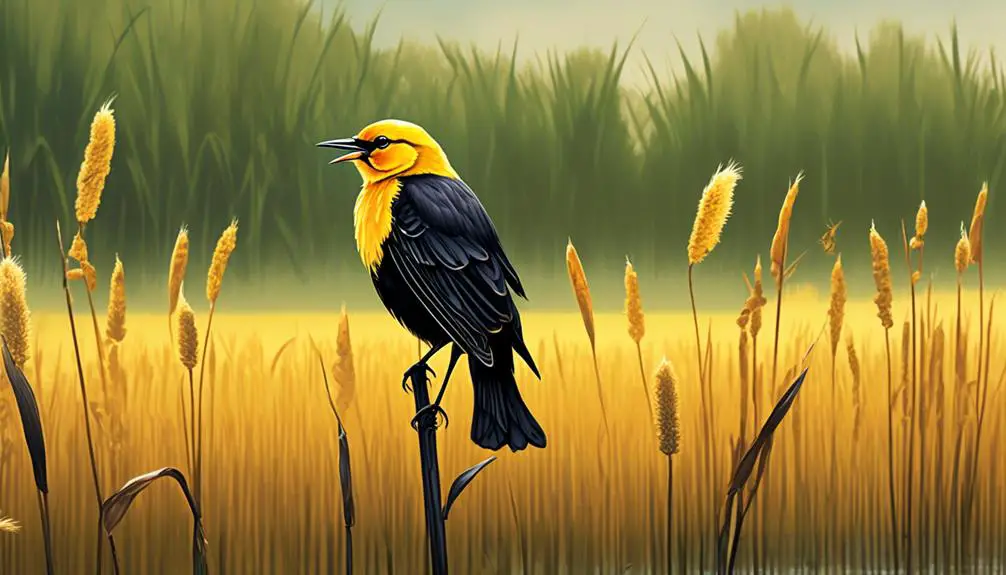
The Yellow-Headed Blackbird, scientifically known as Xanthocephalus xanthocephalus, is a striking yellow bird species found in marshes throughout North and Central America. With a length ranging from 8.3 to 10.2 inches and a weight between 1.6 to 3.5 ounces, this bird is known for its vibrant yellow head and black body. The male Yellow-Headed Blackbird displays a distinct yellow crown, while the female has a more subdued coloration. This species is well-adapted to its marsh habitat, with its long legs and sharp beak allowing it to forage for insects, seeds, and plant matter.
Yellow-Headed Blackbirds are highly social birds, often seen in large flocks during the breeding season. Their unique call, described as a metallic ‘konk-la-ree,’ is used to establish territory and attract mates. Breeding season occurs from May to July, with nests constructed in tall marsh vegetation. The female builds a cup-shaped nest out of grass and reeds, where she lays 3-5 eggs. Both parents take turns incubating the eggs and caring for the young.
While the Yellow-Headed Blackbird population is generally stable, habitat loss and degradation pose threats to their survival. Conservation efforts are focused on protecting marshes and wetlands, which provide crucial breeding and foraging grounds for this species. By maintaining and restoring these habitats, we can ensure the continued presence of this striking yellow bird in North and Central America.
Canada Warbler
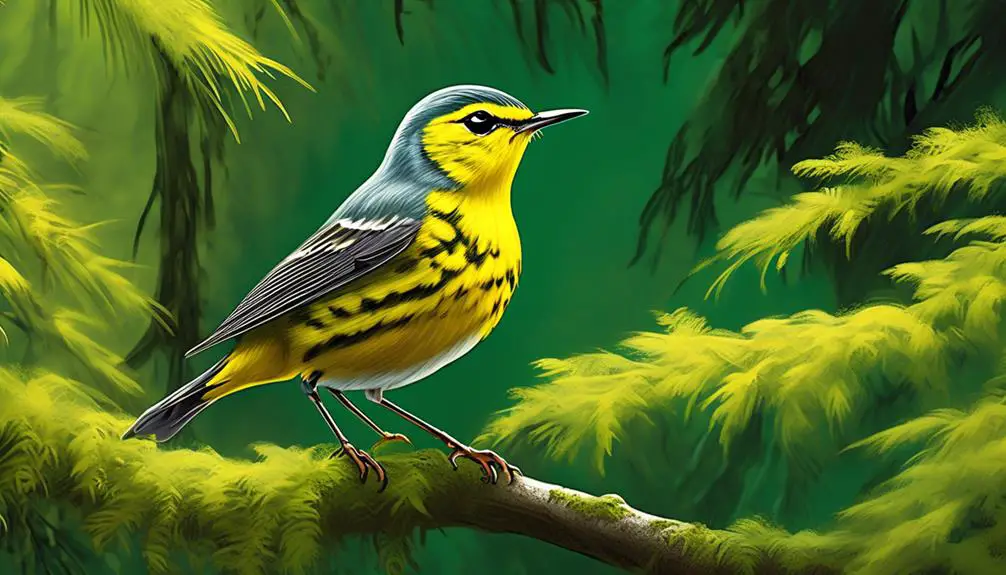
After exploring the fascinating characteristics and conservation efforts of the Yellow-Headed Blackbird, let’s now turn our attention to the Canada Warbler, a remarkable yellow bird species found in North and South America.
The Canada Warbler, scientifically known as Cardellina canadensis, measures between 4.7 to 5.9 inches in length and weighs about 0.32 to 0.46 ounces. This species can be found in moist thickets across North and South America.
The Canada Warbler is known for its distinctive appearance. It has a bright yellow underbelly and a grayish-blue back, with a black necklace-like band across its chest. The males and females have similar plumage, making it difficult to distinguish between the sexes.
In terms of habitat, the Canada Warbler prefers moist thickets and understory vegetation near streams and wetlands. During breeding season, they can be found in the boreal forests of Canada and the northeastern United States. In the winter, they migrate to the forests of South America, mainly in the Andes Mountains.
The Canada Warbler primarily feeds on insects, including caterpillars, beetles, and flies. They forage by hopping along the ground or through the lower branches of trees, gleaning insects from foliage.
Although the Canada Warbler isn’t currently considered threatened, it faces challenges due to habitat loss and fragmentation. Conservation efforts focus on preserving and restoring its breeding and wintering habitats, as well as raising awareness about the importance of protecting this unique species.

Erzsebet Frey (Eli Frey) is an ecologist and online entrepreneur with a Master of Science in Ecology from the University of Belgrade. Originally from Serbia, she has lived in Sri Lanka since 2017. Eli has worked internationally in countries like Oman, Brazil, Germany, and Sri Lanka. In 2018, she expanded into SEO and blogging, completing courses from UC Davis and Edinburgh. Eli has founded multiple websites focused on biology, ecology, environmental science, sustainable and simple living, and outdoor activities. She enjoys creating nature and simple living videos on YouTube and participates in speleology, diving, and hiking.

